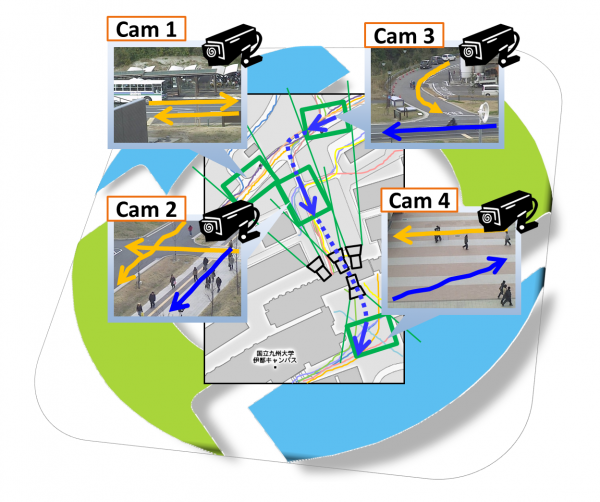Sensor based Cyber-Physical Systems
Outline
Cyber Physical System (CPS) is an attempt to try to build a useful system for society by combining computing capability between real world (physical) and IT (cyber) space. With the development of sensing technology and sensor networks, digital data in the real world came to be incorporated into cyberspace in large quantities. How do we combine the real world and IT space, and contribute to society? The construction of the social system towards the goal achievement is carried out actively. In Kyushu University, as a CPS test head, the eco-promotion in the university and the participation in a complex stakeholder are aimed at using IC card and camera surveillance system, as shown in Figure 1.
Detail
The enormous information about people and environment in the real world acquired from sensor networks is analyzed and fused using IT technology. It is called Cyber Physical System (CPS) to feed back that information to the real world directly or using means such as a policy and management. CPS aims to construct a social system to plan social efficiency, safety, energy saving and CO2 reduction using IT environment. In Kyushu University, the large-scale CPS project is planned aiming at the eco-promotion and the participation in a complex stakeholder.
In the CPS project for Kyushu University, not only the real world data acquired from small wireless base stations (MIMO-Mesh) and camera sensors for surveillance but also individual action history obtained from IC card is used. It can be said that individual action history obtained from IC card (at a campus entrance gate, at a library and the product purchase at a purchasing section) is a powerful element can analyze the whole aspect of the system from more micro viewpoint. By using personal information actively, not only the optimization the whole system but also the development and extension to individual adaptation type service are expected.
We are analyzing the people flow and traffic flow using the video data obtained from sensor networks which distributed multiple cameras. It comes to be possible to model the flows of moving objects in large area by extracting moving features of moving objects inside a photography domain of each camera sensor as shown in Figure 2 and integrating photography domains. If the constant moving path of objects such as people or cars those pass inside the photography domain of each camera sensor or across camera sensors is detected as a moving model, we think that it can be used to solve the congestion situation at a parking and neighborhood of bus stop in university. Also, it is possible to contribute to ecology in university based on the real world data obtained from camera sensors by controlling the lighting time at night in response to changes of the amount of flow.
Now, we install more than ten camera sensors in the passage of the tenth floor of the Ito campus No.2 and carry out the walker flow analysis as a part of the CPS project for Kyushu University. If the validity of this analysis can be shown in future, we plan to expand the proof field from inside the campus to the local whole area.
Publications
International Conferences (Peer-reviewed)
- Atsushi Shimada, Shigeru Takano, Shigeaki Tagashira, Rin-ichiro Taniguchi, Hiroto Yasuura
Estimation of Electric Power Consumption of Individuals by Observing People's Activity
International Conference on Cyber-Physical Systems, CD-ROM Proc. of the Third International Conference on Cyber-Physical Systems (ICCPS 2012), 2012.04
(Keyword: cps)
BibTeX - Sumihiro Ohno, Atsushi Shimada, Hajime Nagahara, Rin-ichiro Taniguchi
Optical Flow based Activity Correlation Analysis in Multiple Non-overlapping Camera Views
CD-ROM Proc. of the 7th Joint Workshop on Machine Perception and Robotics, 2011.10
(Keyword: cps)
BibTeX


